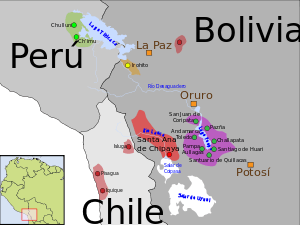Uru–Chipaya languages
The Uru–Chipaya family is an indigenous language family of Bolivia.
| Uru–Chipaya | |
|---|---|
| Uruquilla | |
| Ethnicity | Uru |
| Geographic distribution | Lakes Titicaca and Poopo, Bolivia |
| Linguistic classification | One of the world's primary language families |
| Subdivisions |
|
| Glottolog | uruc1242[1] |
 Current distribution of Uru-Chipaya-speaking peoples | |
The speakers were originally fishermen on the shores of Lake Titicaca, Lake Poopó, and the Desaguadero River.
Chipaya has over a thousand speakers and sees vigorous use in the native community, but all other Uru languages or dialects are extinct.
Loukotka (1968) also lists the Chango language, once spoken on the coast of Chile from Huasco to Cobija in Antofagasta Province. The population has since been Araucanized.[2]
Language contact
Jolkesky (2016) notes that there are lexical similarities with the Kunza, Pukina, Pano, Jaqi, Kechua, Mapudungun, and Moseten-Tsimane language families due to contact.[3]
Bibliography
- Aguiló, F. (1986). El idioma de los Urus. Editora Centro Portales.
- Cerrón-Palomino, R. (2011). Chipaya. Léxico y etnotaxonomía. Lima: PUCP.
- Espinoza Soriano (1991). Proto-Takanan and Uru-Chipaya: genetic relationship or ancient loans? Comunicação apresentada em: Conferencia Internacional sobre Lenguaje, Política Oficial sobre el Lenguaje y Política Educativa en los Andes, 28–30 October 1991. Newark: University of Delaware.
- Hannẞ, K. (2008). Uchumataqu: The lost language of the Urus of Bolivia. A grammatical description of the language as documented between 1894 and 1952 (ILLA, 7). Leiden: CNWS Publications.
- Nimuendajú, K. (1928-1929). Wortliste der Šipáya-Indianer. Anthropos, 23:821-850, 24:863-896.
- Snethlage, E. (1932). Chipaya- und Curuaya-Wörter. Anthropos, 27:65-93.
- Vellard, J. A. (1949-1951). Contribution à l'étude des Indiens Uru ou Kot'suñs. Travaux de l'Institut Français d'études Andines, 1:145-209, 2:51-89, 3:3-39.
gollark: We should use the minimal ruleset plus some tweakß.
gollark: !laser geckoes --deploy
gollark: B L O C K C H A I N?
gollark: Ha, saying that it's not an April fools joke makes it an even funnier April fools joke.
gollark: The april fools' joke on <#553993009323180034> is hilarious.
References
- Hammarström, Harald; Forkel, Robert; Haspelmath, Martin, eds. (2017). "Uru–Chipaya". Glottolog 3.0. Jena, Germany: Max Planck Institute for the Science of Human History.
- Loukotka, Čestmír (1968). Classification of South American Indian languages. Los Angeles: UCLA Latin American Center.
- Jolkesky, Marcelo Pinho de Valhery (2016). Estudo arqueo-ecolinguístico das terras tropicais sul-americanas (Ph.D. dissertation) (2 ed.). Brasília: University of Brasília.
This article is issued from Wikipedia. The text is licensed under Creative Commons - Attribution - Sharealike. Additional terms may apply for the media files.